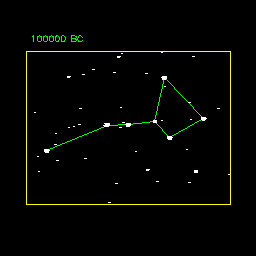Blog
Blink of an Eye
1 November 2014
 NASA
NASAOne of the aspects of astronomy that’s hard to wrap your head around is the immense time scales of the heavens. We measure the lifetimes of stars in billions of years, while the light from the nearest galaxies takes millions of years to reach us. Human civilization, on the other hand, is measured in thousands, and a human lifetime tens. On a cosmic scale, our view of the universe is a mere blink of an eye.
 Wikipedia
WikipediaAs a result, we tend to view much of the cosmos as unchanging, when it is actually quite dynamic. Currently the north star is the star Polaris, but a few thousand years ago it was the star Thuban, and a few thousand years from now it will be the star Vega. In addition to rotating, our planet wobbles like a top. We just don’t notice it on the scale of a lifetime.
The Sun is not fixed in space, but moves in an orbit about the galaxy. Other nearby stars move as well, and thus their positions in the night sky change over time. Over tens of thousands of years, the constellations shift and transform into new shapes. Our familiar Big Dipper, for example, will soon have a very different appearance.
Over millions of years, the Sun’s path will wobble in and out of the plane of the Milky Way. There is some evidence that this motion through the galaxy has an affect on climate on a geologic scale, and there have been some proposals that it could produce periodic mass extinctions.
On the billion-years scale, our Sun will continue to rise in temperature until it becomes a red giant. Earth will become far too hot for most life to remain, and humanity will either have moved on to greener pastures or have become extinct like so many species before it.
While it’s generally thought that there are likely other forms of life in the universe, Earth remains the only place we know of where creatures look up at the sky and truly understand on some level what the cosmos actually is. It is worth remembering how fortunate we are to step into the sunlight and blink our eyes.